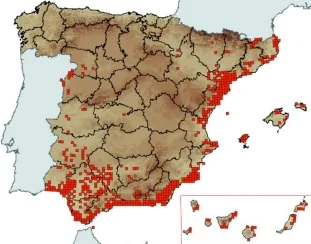In recent years, the uncontrolled spread of the Cochineal, Dactylopius coccus (Cochinilla del Carmin) has led to the near disappearance of the prickly pear (higo chumbo) in Spain. So lets explore our lost heritage: cochineal and the endangered prickly pear in Spain
Historical Significance
The introduced prickly pear (Opuntia maxima), originating from Central America, has played a vital role for centuries. It served various purposes, including being a source of food (prickly pears, higo chumbos), livestock feed, agricultural support, slope stabilization, and hedges.
Cultural Impact and distribution in Spain

Historically, it has been a lifeline in arid regions of the southern and southeastern Iberian Peninsula, alleviating hunger. In the Canary Islands, it is cultivated for cochineal extraction, holding a designated origin certificate since 2016. Cochineal dye, a natural colorant (E-120) with carminic acid as its main component, finds applications in the food industry, cosmetics, pharmacy, and more. The color varies based on its interaction with acids, bases, or the formation of aluminum salts (carmine).
Historical Roots
Cochineal farming traces back to pre-Columbian times in Mexico, later exported to the Canary Islands and other compatible climates. Its economic importance was substantial, replacing or complementing other dyes in the market post the discovery of America.
Rise of Cochineal as a Plague
In Spain, however, cochineal has evolved into a plague. The aggressive strain, considered a wild species within the same genus, has strayed from the carefully selected strain used for centuries in dye production. It is suspected to have escaped its intended use as a biological control measure, leading to considerable controversy. Since 2009, the prickly pear has been on Spain’s official list of invasive species.

Controversy and Perspectives
While some see this infestation as a natural remedy to eradicate invasive exotic cactus species (similar to the situation with the agave weevil), others, myself included, argue that prickly pears have been an integral part of our landscape for centuries. We believe that, at the very least, the specific species (Opuntia maxima) and its variations can be preserved in locations where they have traditionally thrived and been cultivated.
Spider habitat
the Tent-Web Spider – Cyrtophora citricola – Araña orbitela de las chumberas
In Spain it was once very common to see their webs in prickly pears (Opuntia), where they often grouped together, ranging from a few individuals to colonial webs of several meters in length with many hundreds of spiders. The Spanish common name for this spider even uses the prickly pear, Chumbera!

However, in recent years and with the uncontrolled spread of the Cochineal – Dactylopius coccus – Cochinilla del Carmin the prickly pear habitat for this spider has all but been lost across the Iberian Peninsular. Read more about this lovely spider here: https://wildsideholidays.co.uk/tent-web-spider-cyrthophora-citricola-arana-orbitela-de-las-chumberas/
Some alternative titles for this article
- The Cochineal Invasion: Unraveling the Prickly Pear’s Disappearance in Spain
- Cochineal Plague: The Vanishing Act of the Prickly Pear in Spanish Landscapes
- From Bounty to Blight: The Cochineal Crisis and Spain’s Prickly Pear
- Cactus Catastrophe: Spain’s Battle Against the Cochineal Menace
- Hues of Change: Cochineal and the Tragic Decline of Spain’s Prickly Pear
- Cultural Icon to Invasive Threat: The Tragedy of Spain’s Prickly Pear
- In the Shadows of Red: Spain’s Prickly Pear Faces Cochineal Devastation
- Prickly Perils: Navigating the Cochineal Onslaught in Spain
- Lost Heritage: Cochineal and the Endangered Prickly Pear in Spain
- Invasive Reds: The Cochineal Dilemma and Spain’s Prickly Pear Plight
Ronda Today
Everything you need to know before you visit Ronda “The city of dreams” in Andalucia. https://www.rondatoday.com/
Visit Cádiz
Planning on visiting Cádiz? Tourist information. Monuments. Hotels. Activities. City guides: https://visitingcadiz.com/
The Caminito del Rey
Find tickets for the Caminito del Rey: https://www.caminodelrey.es/
Wildside Holidays – Spain
Take a trip on the Wildside! Discover the wildlife and nature of Spain, its Natural and National Parks and find the top wildlife, activity and walking holiday companies.
Iberia Nature Forum
Discover the Iberia Nature Forum – Environment, geography, nature, landscape, climate, culture, history, rural tourism and travel.
I’ve been living in this lovely area of Western Andalucia for the last 20 years or so and dedicate most of my time to the running of English language tourist information websites for the towns of Cádiz, Ronda, Grazalema, the famous or infamous Caminito del Rey, and also Wildside Holidays, which promotes sustainable and eco-friendly businesses running wildlife and walking holidays in Spain. My articles contain affiliate links that will help you reserve a hotel, bus, train or activity in the area. You don’t pay more, but by using them you do support this website. Thankyou!

I think the article could be clearer if you explained that Dactylopius coccus* is an insect.
Fun fact, the dwarf kermes oak (Quercus coccifera*) known locally as ‘coscoja,’ is the habitat of the kermes insect, another natural source of crimson dye ( from Arabic- qirmiz, qirmizī).
*Coccum/ κόκκος ‘berry.’
Cordially,
Thats interesting Arthur!
Hi Clive, thanks for this article. I am starting a project about the global history of the prickly pear. Would you be open to sharing some of the references you used to write this article? Many thanks!
I live and work a small farm in western Andalusia. For us the prickly pear cactus is the bane of our lives, the problem being that, where it grows on a slope, it eventually falls over and regrows where it lands thus spreading itself rapidly and requiring us to clear it from around olive trees. The clearing of it is an extremely unpleasant job due to its prickles and becomes a constant battle. True – it forms an effective fence and firebreak, but don’t let it grow on a slope.